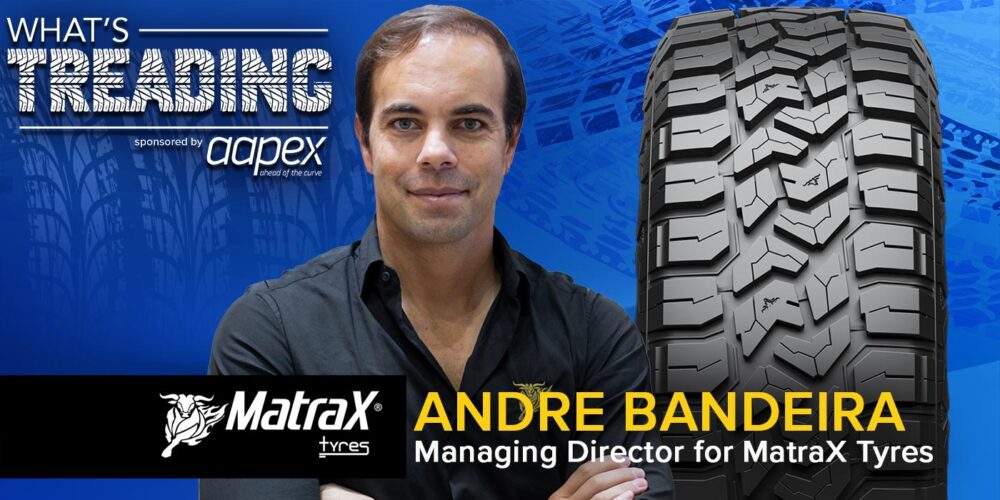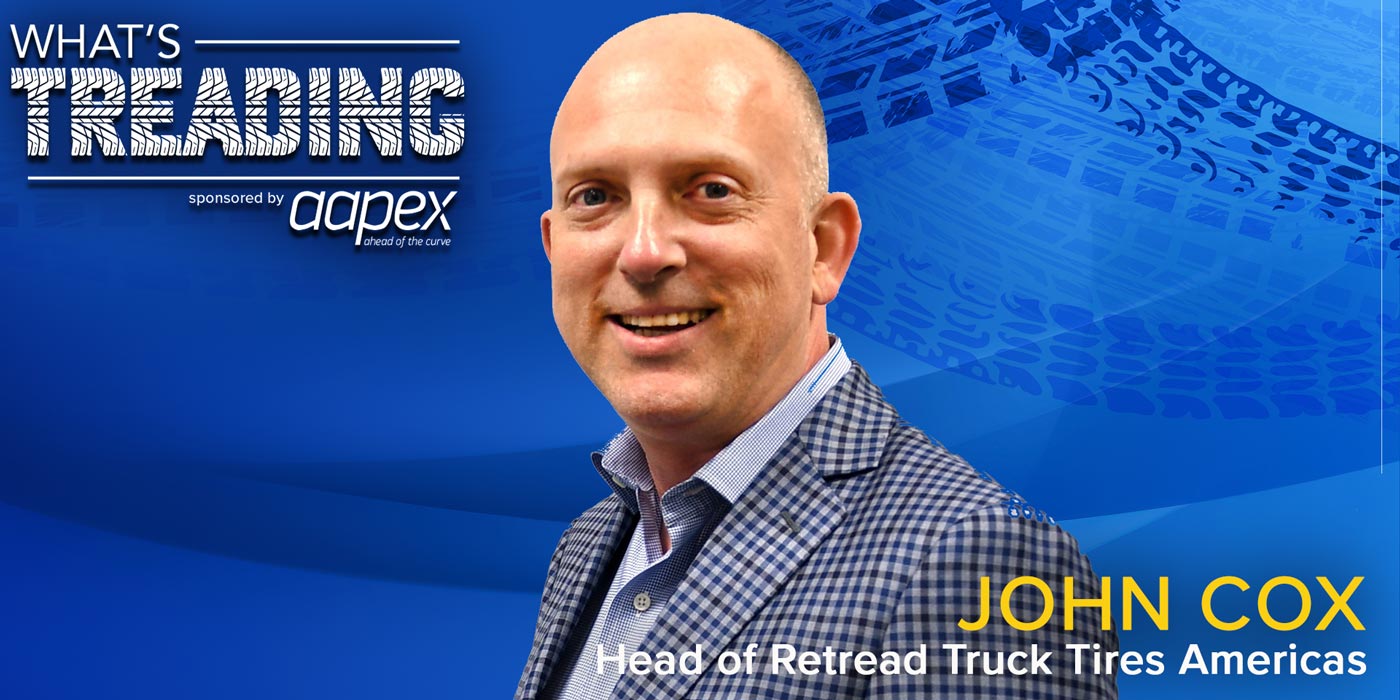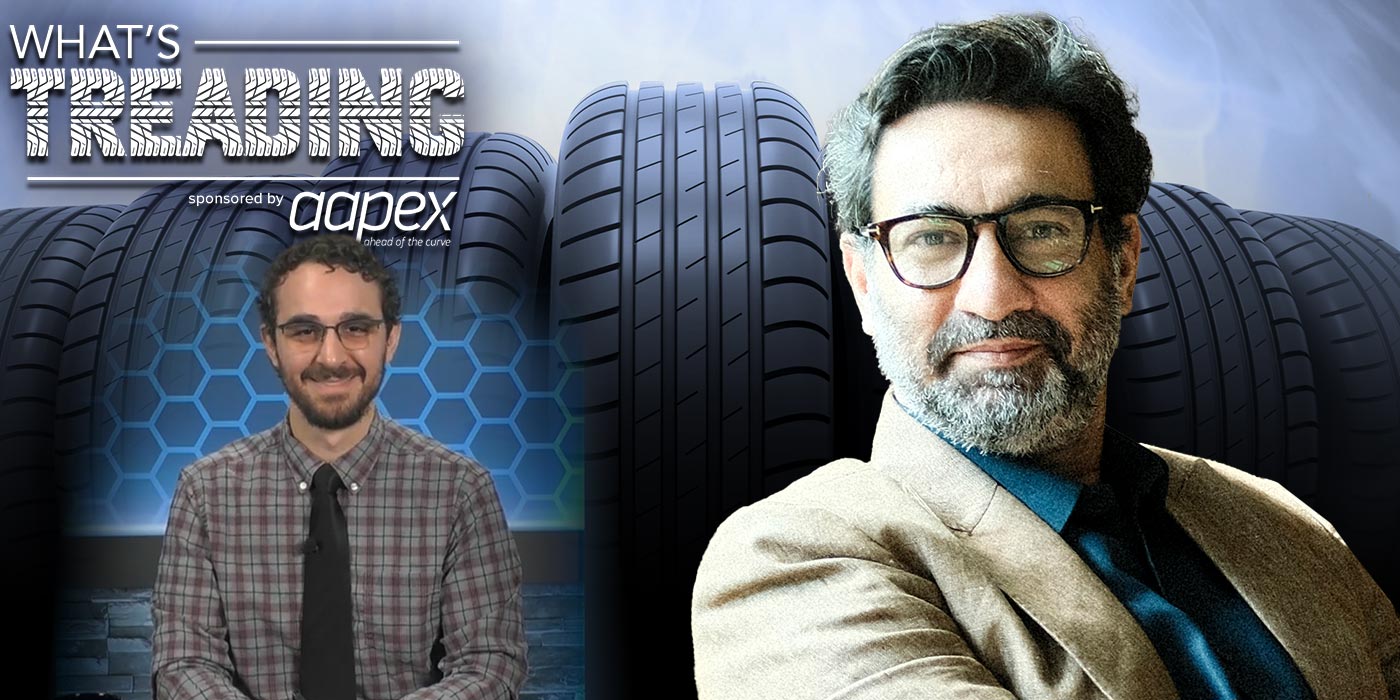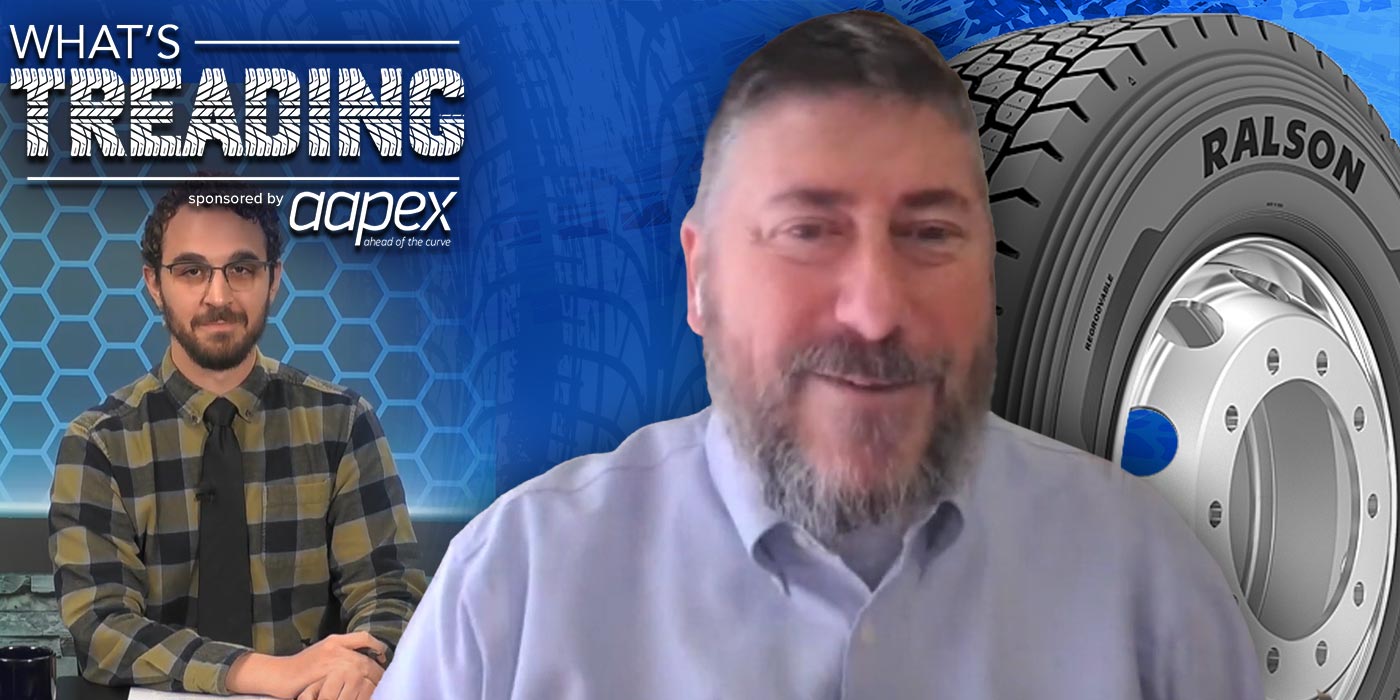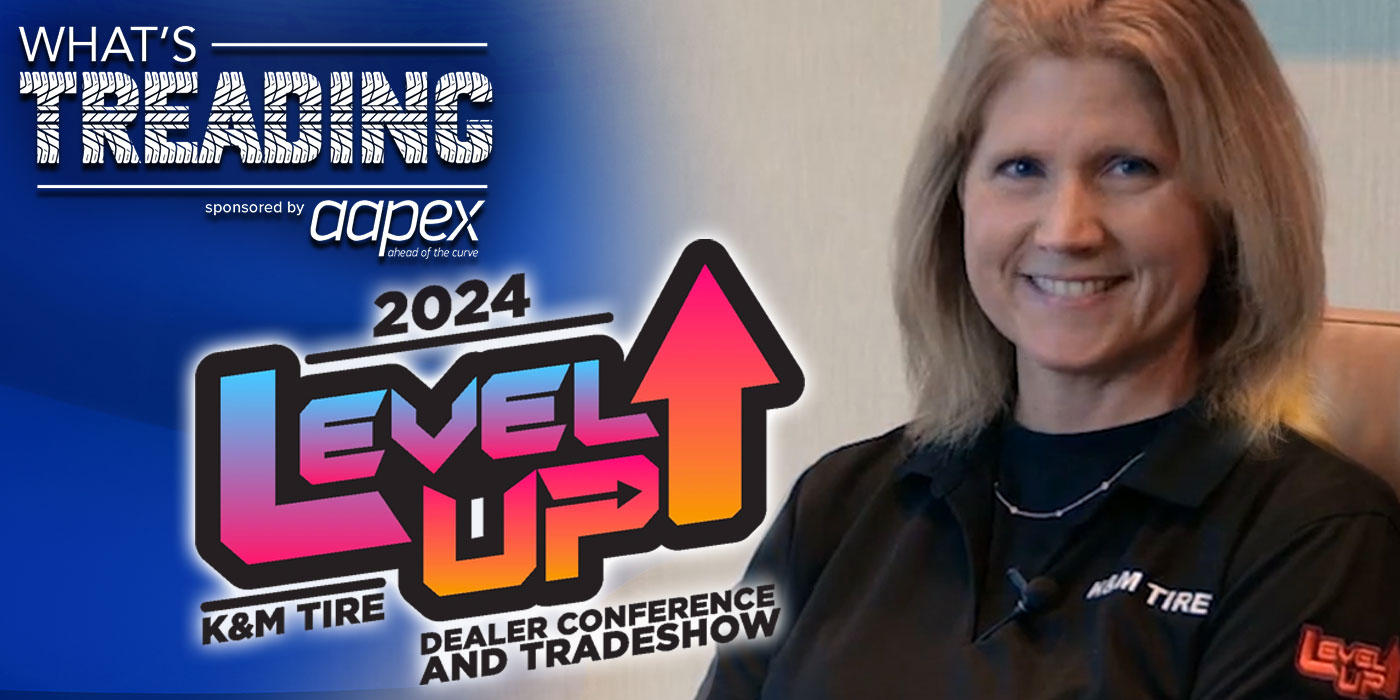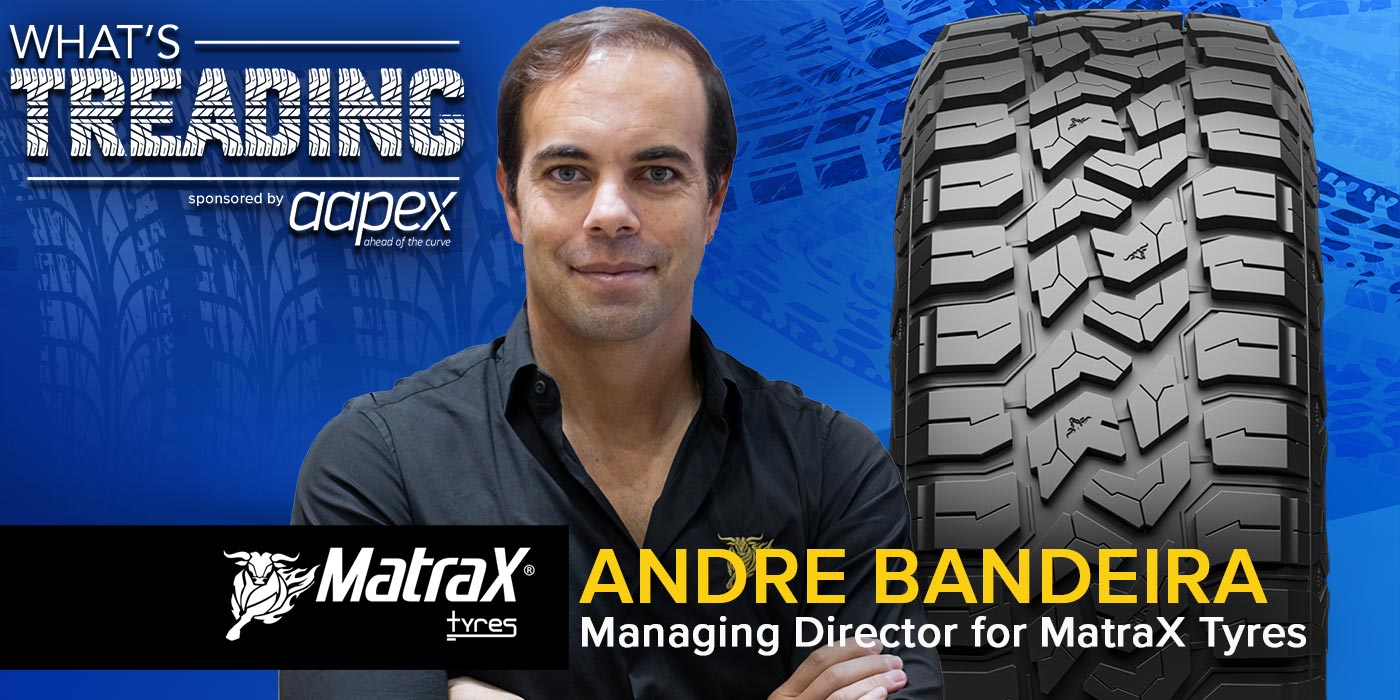Kumho Tire recently launched the Solus TA51a tire, a grand touring all-season tire that consolidates two products into one. Kumho has also been simplifying other product lines as well; According to Shawn Denlein, president of sales and marketing at Kumho Tire USA, it’s a strategy that will become a huge boon to tire dealers.
“In 2018 we started this strategy of trying to consolidate all the lines, and there’s a lot of benefits to this,” Denlein says. “One, you have an extreme benefit from the manufacturing side, because you’re able to concentrate obviously just on one tread. From a developmental side, it’s also important because it allows the engineers just to focus on one tread. From the dealer side, you’re carrying less inventory and it’s not as complicated. Back in 2018 we had 13 treads and now we have nine.”
On this episode of What’s Treading with Tire Review, we grill Denlein on details about Kumho’s new TA51a grand touring all-season tire, tire segments the company has its eye on, and how expanded warehousing is expected to help tire dealers in North America.
Want more What’s Treading? Click here.
Here’s a transcript of the show:
Maddie Winer: Welcome to What’s Treading with Tire Review presented by AAPEX. I’m Maddie Winer and today on the podcast we’re joined by Shawn Denlein, president of sales and marketing for Kumho Tire USA. Shawn, thanks for being with us today. Welcome to the show.
Shawn Denlein: Hi Maddie. Yes, looking forward to speaking with you. Great to see you.
Maddie Winer: Thanks, same to you. So, Kumho’s had a lot going on this year. You guys recently launched the Solus TA51a, a grand touring all-season tire. Tell us about that tire, what that replaces and the response you’ve gotten from the market on that product.
Shawn Denlein: We launched that tire roughly two months ago and that replaced retreads actually. So it replaced the TA11, which is a standard touring tire, TA31 and TA71 which is a grand touring tire. Some of the big things about the product line is that it covers a wide variety of sizes. There are 82 sizes, so it’s really good because it fits SUVs, CUVs, and sedans. One of the things that you’ll notice about that tire is it has an “A” at the end of it, so “A” stands for America. It’s the first time that we’ve ever done this. The reasoning behind it is because we wanted the consumer to understand that the attributes of the product really represent the United States. We’re a global company and also a global manufacturer, but in this particular case we really wanted to showcase to the consumer that this product was made for the US.
In terms of feedback, the dealers themselves really like the design of the tire. They really like the size lineup, because, as you know, in today’s environment, dealers are really concerned about their inventory. They are keeping a close watch on their inventory. So this allows them to carry one tread across the large footprint. We also had the dealers go out and test the tire beforehand and we got a lot of positive reviews with that, which was good. So, I think what we did here is we developed a tire that really fits the grand touring market. It has the attributes of a tire that’s good wet, winter, and at the same time we don’t sacrifice that dry handling and the comfortability of the product.
And as far as the consumer, the tire’s only been out for two months, but we’re hoping that we get some positive feedback from the consumers on it. What’s interesting is that, from a company perspective, we chose to really go in full throttle with this product, because this product has grown in the last six years, roughly 6% at the grand touring market. We don’t expect it to grow that much. 2.5% is what we’re projecting out over the next few years, but it’s still a sizable part of the market. This grand touring has really taken over that standard touring and that broad market, which is T speed rated and less. So this is this really a bread and butter for a manufacturer, so you really have to come out with a product that performs.
Maddie Winer: Yeah, for sure. And you’re talking about, you said 82 sizes, did I hear that right?
Shawn Denlein: 82 sizes: T, H and V.
Maddie Winer: Okay. So yeah, we’ve been seeing a lot of those, I don’t know, I like to call them like mega lines or mega tire lines. And really covering a lot of different fitments. Can you maybe go into the reason for doing that?
Shawn Denlein: Well, as the market grows, the CUV market is growing, as you know. There’s a point in time where well over 50% of the vehicles are going to be on some type of platform like that. So I think it’s just important for companies to have such a broad size lineup to cover those fitments. So you have that crossover CUV, and you still have this product line that can still service the sedans, but it really targets in on that and you get that quiet, comfortable ride too.
Maddie Winer: Yeah, makes sense. And yeah, definitely exciting launch for you guys.
Shawn Denlein: Yes, very exciting for us.
Maddie Winer: So Shawn, you mentioned the launch of the Solus TA51a, consolidates two products into one, and Kumho has been simplifying other product lines as well, like it’s MT tire. So can you give us an update on how all of that’s going, all of the line consolidation, if you will.
Shawn Denlein: So that started in 2018 when we started this strategy of trying to consolidate all the lines. And there’s a lot of benefits to this. One, you have a extreme benefit from the manufacturing side, because you’re able to concentrate obviously just on one tread. So it makes the efficiency much better. Even to go along with that, even when we actually inventory product, we’re only inventorying basically one tread. So from a developmental side, it’s also important because it allows the engineers just to focus on one tread, so you’re not focusing on multiple treads, therefore that you can put your focus on really trying to create what we would call a best in class product. And then from the dealer side, like I said, you’re carrying less inventory and it’s not as complicated. So overall that just continues to be the strategy. Funny, but back in 2018 we had 13 treads and now we have nine. And we have one left, which is the ultra-high performance that currently has PS31 and PS91.
Maddie Winer: Is that line the Ecsta line? Is that correct?
Shawn Denlein: Yeah. So, we’ll have that, we’ll end up being consolidated in 2025. So moving forward, we’ll basically hover around eight, nine treads and it just makes lifecycles easier for us and obviously easier is better even for the dealers, as you know.
Maddie Winer: Yeah, there’s so much skew proliferation in the market today and it’s probably easier just inventory wise for dealers. So yeah, I’m interested to see how that goes. And definitely we will keep an eye out on those products. So for Kumho, I’m curious, switching gears here, what do you see are some maybe growing tire segments that Kumho has its eye on for maybe some possible category introductions or something like that?
Shawn Denlein: Well, obviously number one with everybody is EV.
Maddie Winer: Yeah, right, of course.
Shawn Denlein: EV, everyone has their eye on EV. It’s the new buzzword in the industry. At this point, we’re integrating our technology into existing products for EV. We do have a proprietary technology called K-Silent and just a high level view of K-Silent, the premise is to create a product that reduces noise. This was one of the challenges in that industry in terms of EV. The other thing too with us is that we do have two OE fitments. We are EV6, the Kia EV6, and the Volkswagen ID.4.
From our standpoint, we’re taking a look at to see how the industry shakes out. Right now, our direction would be more towards creating products for EV dedicated product lines. So for summer, winter, going along that route is where we’re headed now. Another segment would be the RT segment. So the rugged terrain segment become very popular with consumers. We have our full complement of truck, the Crugen HT51, the AT52, and then also the road venture MT71. So RT segment, as you know, that’s that hybrid between the AT and the MT. So that’s a segment that we are currently working on bringing out a product for that segment. Another segment that’s actually really, really big is the all weather segment.
We to had a product called the HA31. That product was really more towards regionally based, dedicated, and it wasn’t really fully supported in the complement from our products. So in the next year or so, we’ll come out with a all weather product. And one of the key points here is that in the past three years, that segment’s grown 32%. And what we’re thinking is this year it’s going to grow 23 plus percent in a industry as you know that’s down.
Maddie Winer: Yeah. Which is interesting for that segment.
Shawn Denlein: Yeah. So for us, from a growth perspective, coming out with an RT and then also coming out with the all-weather product, and then we’re already focused in EV, there’s a lot good growth potential for Kumho in those particular segments that we have our eyes on.
Maddie Winer: Yeah, for sure. It sounds like it. And yeah, the RT segment and the all-weather we’ve definitely been hearing from manufacturers of those are two segments that they’re going after. And also, I’m curious, you mentioned that Kumho’s strategy around that is having dedicated tire lines in addition to more, I guess, ICE vehicle focused. Does that make sense? Am I getting the right?
Shawn Denlein: At this point, it would be more towards having an EV on the sidewall. So it would have the actual and then slash or some type of form that would say actually EV.
Maddie Winer: Got it, got it. And all that is in the works in development.
Shawn Denlein: Now all that’s currently in the works, yes.
Maddie Winer: Oh, okay. Very cool, very cool. Well, yeah, I’m interested to see how that rolls out. And now Kumho also announced a few years ago an expansion of its US tire plant in Macon, Georgia. That was slated to increase capacity by, I have 500,000 units per year. So, a Q4 2022 completion date was on the books for that. You guys also announced that you’re doubling capacity at your Vietnam plant with a huge investment. So where does the US plant stand now with capacity?
Shawn Denlein: So the Macon Georgia plant was delayed and primarily due to the pandemic hangover, so to speak, so you are correct, 3.2 million units. And in 2024, we’ll move to that number of 3.7, which is adding 500,000 units. Now from the Vietnam side. Now this Vietnam, the Vietnam plant is a plant that we get a lot of production from there. So it really services the US. Last year that plant was producing 5 million tires. Now the plant is producing to the schedule of 10 million. And then in 2024, it will reach the capacity of 12 million tires. So really good for our customers here. That plan is really there for the US and that capacity to really service this US market.
Maddie Winer: Got it, got it. So the Solus TA51a, you said that A at the end stands for America, correct?
Shawn Denlein: Yes.
Maddie Winer: So is that tire being made at the Macon plant or a little bit of both, or?
Shawn Denlein: No. So that tire’s coming out of the Vietnam plant. Really the reason for the A is because when we designed the tire, the tire is for the American market. So when we looked at the tire designed it, there’s certain attributes of this particular market that are much different than the European or Asian market. Consumers are a little bit more focused here on low noise, durability. So that’s really why we did the A, it was more for a technological denotion than anything else.
Maddie Winer: Yeah, no, that makes sense. And I know that dealers, that’s a selling point for dealers too, is this product was made in America. A lot of consumers like to hear that, and if not made, R&D and tested here too. So that I know is a selling point.
Shawn Denlein: Yeah, I think in the industry, they’re products that are sold in other areas and it’s it hard to make a perfect tire. I don’t think anyone makes a perfect tire. And I think that as consumers, they want a perfect product. But when you start to develop products that are more for global markets, including your market, and you do run into some challenges in terms of what the consumer demands here in the US versus someone in Europe that might not necessarily be more focused on tread wear.
Maddie Winer: Yeah, totally.
Shawn Denlein: Like we are here in the US for example.
Maddie Winer: Yeah, no, that makes a lot of sense. And speaking along the lines of expanding capacity, obviously that affects warehousing in the US. And so with additional capacity that you guys are adding to both plants, the Vietnam and the Macon Georgia one, Kumho announced the addition of two warehouses, one in Dallas and another in Louisiana expected to open in 2026. So how will these projects help Kumho’s US dealers?
Shawn Denlein: So right now we have a warehouse on the west coast in California, and then we have a warehouse on the east coast in Georgia. And when we looked at the serviceability and the demands of the dealers, we wanted to put a warehouse where we felt like we could service a good network of our dealers. So we chose Dallas and for the obvious reason to better service the central part of the US. And so that’s really the main purpose there. And for the dealers that you cut down lead times, you’re able to obviously have more product and you’re also able to have the product what they need in a timely basis.
The Louisiana in 2026 will help us better service that southeast. And then also that warehouse too will be not far from the port. So for us, we have the warehouse in California, which is not far from the Long Beach port. And then we’ll have the warehouse here in Georgia, which is not far from the Savannah port. And now we’ll have the one in Louisiana, which will enable us to utilize that port. So it gives us a lot of flexibility with that. So the other thing too is that the warehouses allow us to bring more product in and have safety stock, which is really important and take advantage of business opportunities that come up. And we don’t have to wait a couple of months because we have the inventory stateside.
Maddie Winer: Right. And every tire manufacturer I talked to during the pandemic, obviously supply, you mentioned it earlier, supply was a huge challenge. So you’re saying bringing more of that supply local, whether it’s made here or made elsewhere and having it on hand.
Shawn Denlein: Yeah, because I think everybody, a little bit learned too from the pandemic was their supply chains, their warehouse, their proximity to ports. Everybody got their safety stock, when we were coming out of COVID, got eaten up by the dealers because business got back in a quick way. So in the past manufacturers would have safety stocks. But that was a bit of a challenge for all of us. And also, like I said, I think you need to take advantage of opportunities right away when they come. And if you have product here, then you can take advantage of some quick wins that you might have with some of your customers.
Maddie Winer: That makes sense. And dealers will be happy about that, I’m sure.
Shawn Denlein: Yeah, I don’t want seem like we’re someone else’s warehouse, but we’re trying to provide the products that they need in a quick manner.
Maddie Winer: That’s great to hear. Well, Shawn, just to wrap up here, what do you want dealers to know about the Kumho Tire brand going forward into 2023? And can you mention any new products that we can expect this year?
Shawn Denlein: So this year the sole product that we launched was the TA51a, which was two months ago. As far as the brand is concerned, a few things I would say, not necessarily in any order, but I would say the first two would be paramount, that would be communication. I’ve been in the industry for almost believe it or not, 30 years. I really learned that communication is important. Communication in what we’re doing and what we’re doing wrong. I think you need to communicate, because if you don’t do that, then you’re just not listening. And as you know, because been in the industry too for a little bit that it’s changed a lot over the years. And everybody’s business is really different. So we really have to take the advice of the dealers and try to learn as much as we can and try to adapt.
The other thing too, and we’re doing more and more of this every year, and this is important, and we’re doing this with a lot of dealers, and that’s collaboration specifically around our products and our programs. And I think that as we’ve evolved as an industry, logistics are extremely important. And I think that collaborating helps both companies meet some of the challenges that we have in the industry. Also, from a marketing perspective, we’ve been doing a lot of good things over the past few years. I like to call it, we have this, what we would call out more of a outside the box strategy. Our prints a lot different than others. Our tag that we use, for instance, TA51 fits on everything.
We’re using very different types of ads. Our social and digital I also think is very unique to the industry. We’re using a lot of memes, which has provided some real success for us, because our target audience is 18 to 35. That’s really where we’re generating a lot of our social and digital. And we’ve had a lot of success. In the last two years, our followers have grown them 400%. And we’ve been really happy with that. The marketing department has really hit their targets. And for 2023, just to give you some examples, some of our posts, roughly 1.5 million views and over 250,000 engagements.
We really pivoted our social and digital and our print to be a little bit more, not, I would say not traditional in this particular space of tires. And we really, in the marketing side, we really are want to see engagement, really want to connect to the consumer, try to understand the consumer. So if we can build that personal relationship, they can understand the brand. Lastly, I would say for our customers, we still continue to sponsor the NBA.
And we’ve been doing this for many years. People say, “Well, why do you do this?” And I tell them that it’s on the social and digital platforms of nba.com and NBA TV. But what it allows us to do is that we touch a consumer that’s not normally surfing the internet on social channels around tires. So if we can bring them in and engage, we can have a conversation with that. And the other thing is that our target audience is 18 to 35. So the NBA has the youngest audience of all professional sports.
Maddie Winer: Oh, that’s interesting.
Shawn Denlein: So it really fits what we’re trying to do. So if you analyze everything that we’ve done, we’ve consolidated our product lines, we’re trying to make things simple for the dealers. We’re adding warehouses and we’re adding more product, and we’re also adding more capacity in Vietnam. So we’re trying to touch a lot of the points that the others are interested in. And we’re trying to stay real focused on the marketing strategy and who we’re actually trying to target. So I think since I’ve been here since 2018, where we really built out a real nice timeline for what [inaudible 00:22:25] here in the US where we’ve really hit our target. So we’re really looking forward to the next few years of growth based on what we’ve built up already.
Maddie Winer: And it sounds like a lot of growth is on the way, which is very exciting.
Shawn Denlein: Yeah. Even in a market that is as down roughly 6% we’re up compared to last year, and we’re outpacing the market. So we’re pretty excited about the second half of the year.
Maddie Winer: Yeah, for sure. Well, I know we’re excited to see what’s coming from you guys. And Shawn, thanks so much for being on the podcast today. I’ve enjoyed our conversation and I really appreciate your time.
Shawn Denlein: Oh, thank you very much. Look forward to doing it again. Thanks.





